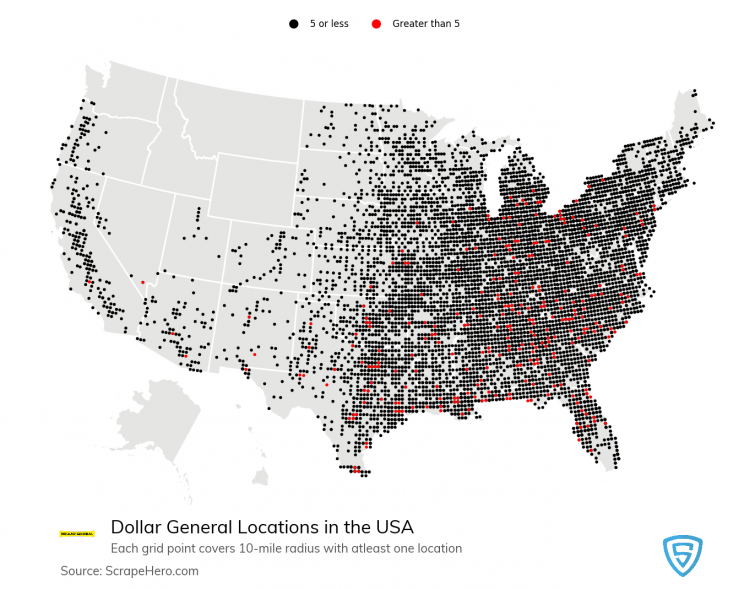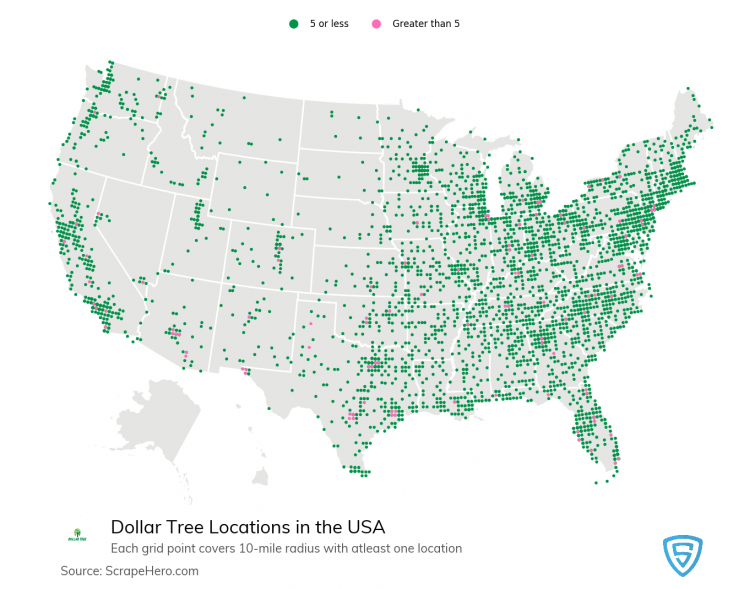Dollar stores are a billion-dollar industry and their popularity is rising, with new stores popping up everyday and raking in profits. There are now more than 32,000 dollar store locations in the US.
By 2025, given how aggressive these companies are, the number of dollar store locations could increase by 20 percent. We took a look at the locations of the biggest dollar store chains in the US – Dollar General, Dollar Tree, and Family Dollar.
Insights in Brief:
- Dollar General has 16,191 stores in 44 states.
- Dollar Tree has 7,296 stores in 48 states.
- Family Dollar has 9,489 stores in 46 states.
- There are more than 32,000 dollar store locations in US.
- The number of dollar store locations is more than Subway (24,044).
You can download the data used for this analysis and more from our data store.
How many Dollar stores are there in US?
There are now more than 32,000 dollar stores in US. Texas has most number of dollar stores with 3,379 stores.
Dollar General DG 114.5 +1.8 +1.6% is the biggest dollar store chain with 16,191 stores across 44 states. Dollar Tree DLTR 98.7 -0.7 -0.7% has the largest state-wide presence with 7,296 stores spread across 48 states. While Dollar Tree owned Family Dollar has 9,489 stores across 46 states.
Dollar Tree and Family Dollar stores are known for selling home goods, accessories, and essentials at prices that start at $1 and don’t typically go past $10. The two stores used to be rival discount chains, but in 2015, Dollar Tree bought Family Dollar for $8.5 billion.
Dollar Stores with Most Locations per State

The map above shows the reigning dollar store in each state. Dollar General dominates in 30 states, most of which are in the central and southern states. Family Dollar outnumbers in 11 states of which 7 are in the western states. Dollar Tree only dominates in 8 states, of which three states are on the west coast.
Although the sheer size of Dollar General and the Dollar Tree family’s domain is astounding, the tendency of dollar stores to open near traditional retailers is what makes them a threat.
Dollar General Locations US

There are 16,191 Dollar General stores in 44 states. The top 3 states with the most number of stores are Texas (1,543), Florida (906), and Georgia (889). Dollar General stores are highly concentrated in the eastern half of the US. States without any Dollar General stores are Alaska, Hawaii, Idaho, Montana, Washington, and Wyoming.
Dollar General prices about 25% of its products at $1 or less and 80% of its items at $5 or less. The retail chain is leaning to digital initiatives introducing Fast Track, a self-checkout designed to enhance in-store labor productivity and customer convenience. It has also started the self-distribution program DG Fresh, which is focused to self-distribute fresh and frozen products.
Family Dollar Locations US

There are 9,489 Family Dollar stores across 46 states. The top 3 states with the highest number of Family Dollar stores are Texas (1,243), Florida (730) and North Carolina (559). Even though Family Dollar stores are concentrated in the eastern regions, it outnumbers Dollar General and Dollar Tree in states New Mexico, Colorado, Arizona, Nevada, Montana, Idaho, and Wyoming.
Download the data used for this analysis and more from our data store.
Dollar Tree Locations US
Dollar Tree stores are ubiquitous nationwide with 7,296 stores present in 48 states. The top three states with the most Dollar Tree stores are California (609), Texas (593), and Florida (540). Washington is the only state that has no Dollar General and Family Dollar stores, but has Dollar Tree stores.
Since August 2019, 283 Dollar Tree stores have opened up. Dollar Tree’s core customers are suburban, middle-income shoppers.
In 2015, Dollar Tree Inc. bought Family Dollar for 8.4 billion. Despite the growth opportunity for dollar-store chains, it’s a competitive field. Dollar Tree’s chief competitor, Dollar General, is trying out smaller-format stores called DGX locations aimed at younger shoppers. The map below shows the Dollar General locations and the locations under Dollar Stores Inc.
The top States with Dollar Stores
The chart below shows the top 15 states with the most number of Dollar General, Dollar Tree, and Family Dollar locations:

Texas has the most dollar stores with 3.4K stores, followed by Florida (2.1K) and Ohio (1.7K). California has more Dollar Tree stores than Dollar General and Family Dollar.
California is a top state for major retailers like Walmart, Target and Whole Foods, however, it ranks 14 when it comes to Dollar Stores.
Rising competition from retailers
Dollar stores are able to compete with big brands because of additional discounts and smaller stores. Yet some cities passed laws curbing the expansion of dollar chains, saying they intentionally cluster multiple stores in low-income areas. This strategy discourages supermarkets from opening and reduces people’s access to fresh food.
Walmart has been experimenting with smaller-store concepts, aggressively trying to squeeze out dollar-stores by offering lower costs. Amazon launched a new section on its site for products $10 and under. These products are similar to what dollar stores sell with Amazon offering free shipping on these items.
The dollar stores are still making money but have work cut out for them, especially when it seems like Amazon and Walmart are rolling out new budget-friendly categories every day.
We can help with your data or automation needs
Turn the Internet into meaningful, structured and usable data










